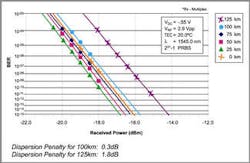InP-based optical components meet metro market demands
By IRVING WANG
CyOptics Inc.
The telecommunications market is rapidly evolving. As the bandwidth bottlenecks are aggressively removed in the long haul backbones, metro and access networks become limiting factors to the future growth of the entire market. Realizing this, carriers have shifted attentions to the metro market--a market that poses new requirements on system design and, in turn, demands new component solutions. Overall cost of ownership, or a combination of up-front equipment cost, size, power consumption, and maintenance cost, must be much lower for a metro system. The response of system vendors is to adapt designs for short reach to work in longer reach applications.
The definition of the metro market itself is also evolving. Metro link lengths used to stretch 40 km to 60 km; Long Metro links now extend up to 500 km. In order to meet these longer link length requirements, the transmitter must have high launch power and low dispersion to minimize the cost of amplification and dispersion compensation. This can be achieved using high-powered lasers and low-chirp external modulators. Several companies are working hard to increase laser power; Continuous Wave (CW) Distributed Feedback (DFB) lasers up to 50 mW are now available on the commercial market. Modulator companies are also improving their products to meet this new demand.
Indium Phosphide-based components
Modulators can be constructed using Indium Phosphide (InP)-based material. Used most widely is the electro-absorption modulator (EAM), which utilizes the Franz-Keldysh effect in Indium Gallium Arsenide Phosphide (InGaAsP). When no electric field is present, the InGaAsP material is transparent. But when an electrical field is applied, the material absorption coefficient increases dramatically, and the EAM chip turns opaque to the incoming light, thereby achieving intensity modulation.
The majority of EAMs deployed in the field so far are monolithically integrated with a DFB laser. Called an EML (electro-absorption modulated laser), this device retains many of the advantages of EAM technology, including low drive voltage and a compact size. However, the need to ensure the proper operation of both a light-emitting section (i.e. laser) and light absorption section (i.e. EAM) forces chip designers to make trade-offs that can limit the performance of both sections. With few exceptions, the transmission range of EMLs has been limited to 60 km.
In the past, this has not been a significant problem for system designers; a Lithium Niobate (LiNbO3) Mach-Zender (MZ) modulator could be used for longer reach applications. And in the early stages of WDM, when cost and size were less of an issue, the bulky, power-hungry LiNbO3 modulator was tolerated. However, with metro market systems now extending up to 500 km, demand is emerging for EMLs that can transmit uncompensated distances of 80 km or more.
While traditional suppliers of monolithic EMLs strive to achieve this goal by refining their product design, others are addressing the problem from a hybrid integration approach. Instead of fabricating the laser and the modulator on the same die, each is fabricated separately to achieve optimal performance. Because InP devices are so compact, the laser and modulator can then be co-packaged in the same package as a monolithic EML. The resulting hybrid EML suffers from none of the performance trade- offs seen in a monolithic chip growth.
Hybrid EMLs exceed 15 GHz in bandwidth and are ideally suited for single span, 10-Gbit/sec transmission up to 125 km. When used in conjunction with amplification and dispersion compensation--which enables very low chirp and a high extinction ratio--they can transmit up to 500 km.
Figure 2 illustrates the test results of a discrete EAM in a 125-km transmission. A negative chirp, evidenced by the negative dispersion penalty at up to 75 km, is produced when additional bias is applied to the modulator. The dispersion penalty at 125 km is less than 2 dB.
The future is integrated optics
There is a clear limit on how much cost reduction can be achieved on discrete components before the cost of packaging starts to dominate the cost structure. The only way to further lower component cost is to package multiple components into a single package. Components fabricated with InP-based compounds lend themselves to such integration, in hybrid forms or monolithically. An increasing number of functions will be built into a single module. Multiple optical and electronic functions such as wavelength locking and RF amplification, for example, can be readily integrated into a single device. Customers seeking increased integration, size reduction, and cost reduction will be able to look to InP optical components to fill these needs.
Irving Wang is product line manager at CyOptics. For more information, visit the company's Web site at www.cyoptics.com.

